Continuous Random Variables
Consider a random experiment where a spinner is spun, and the continuous random variable \(X\) represents the angle spun, measured in degrees over the interval \([0, 360)\).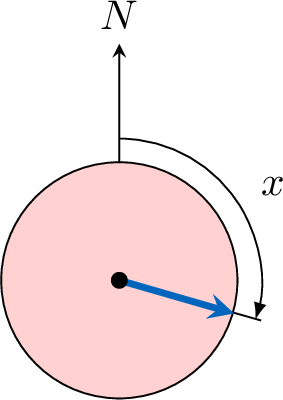
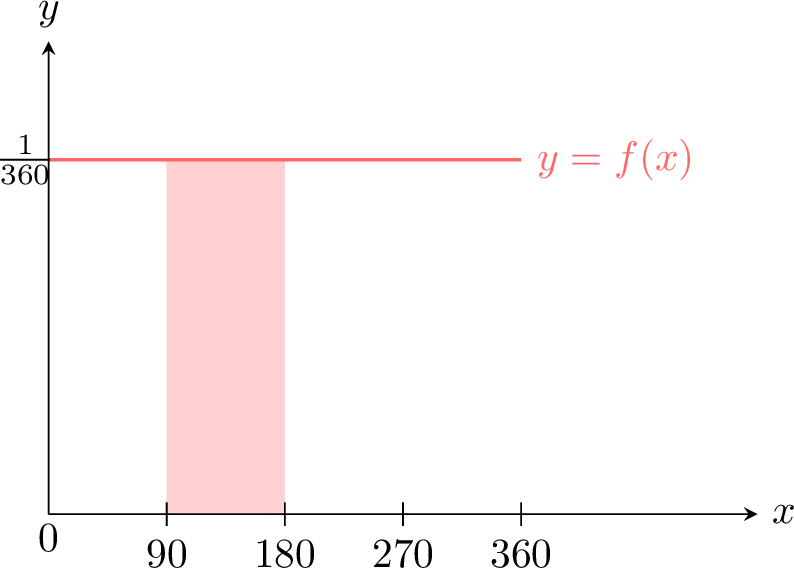


Definitions
Probability Density Function
A probability density function describes the likelihood of a continuous random variable taking values within a specific range. Unlike discrete random variables, where probabilities are assigned to individual outcomes, continuous variables use the pdf to compute probabilities over intervals via integration.
Definition Probability Density Function
A function \(f\) is a probability density function (pdf) on the interval \([a, b]\) if:
- \(f(x) \geq 0\) for all \(x \in [a, b]\) (non-negative everywhere),
- \(\int_{a}^{b} f(x) \, dx = 1\) (the total area under the curve equals 1).
Example
The random variable \(X\) takes values on \([0, 2]\) with density \(f(x) = \frac{x}{2}\).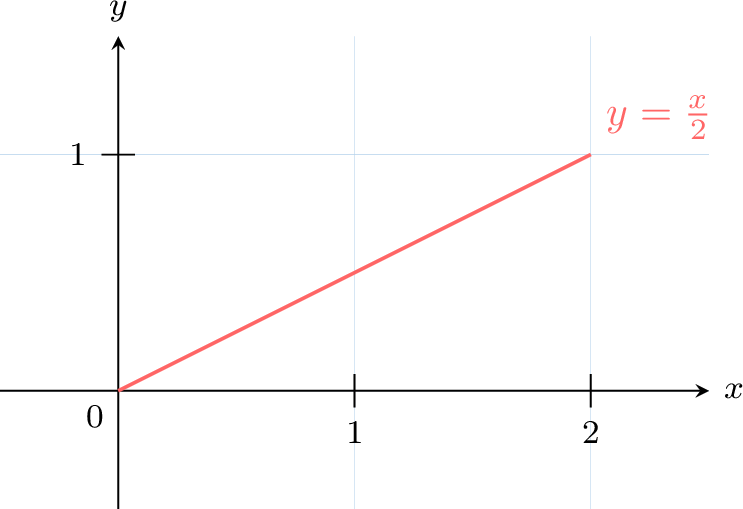

- \(f(x) = \frac{x}{2} \geq 0\) for all \(x \in [0, 2]\), since \(x \geq 0\).
- Compute the total area: $$ \begin{aligned}[t] \int_{0}^{2} f(x) \, dx &= \int_{0}^{2} \frac{x}{2} \, dx \\ &= \left[ \frac{x^2}{4} \right]_{0}^{2} \\ &= \frac{2^2}{4} - 0 = 1 \end{aligned} $$ Since both conditions hold, \(f(x) = \frac{x}{2}\) is a valid pdf on \([0, 2]\).
Definition Density of a Continuous Random Variable
A random variable \(X\) with values on \([a, b]\) has a density \(f\), if the probability that \(X\) lies between \(c\) and \(d\) (\(c, d \in [a, b]\)) is:$$P(c \leq X \leq d) = \int_{c}^{d} f(x) \, dx$$This represents the area under the curve \(y = f(x)\) from \(x = c\) to \(x = d\).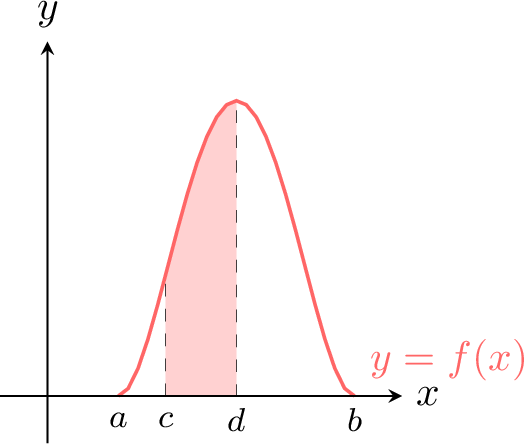

Remark
- Since \(f(x) \geq 0\), \(P(c \leq X \leq d) \geq 0\).
- Since \(\int_{a}^{b} f(x) \, dx = 1\), \(P(a \leq X \leq b) = 1\).
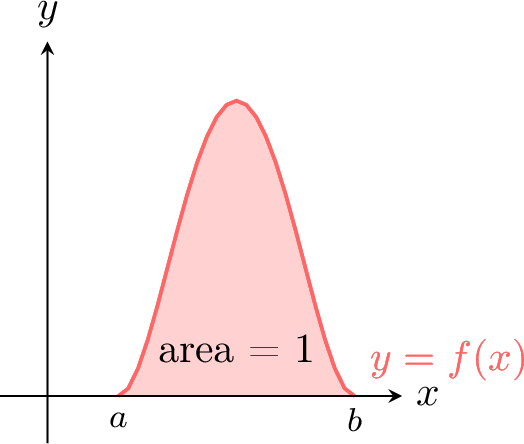
Example
The random variable \(X\) with values on \([0, 2]\) has density \(f(x) = \frac{x}{2}\). Find \(P(1 \leq X \leq 2)\).
$$\begin{aligned}[t]P(1 \leq X \leq 2) &= \int_{1}^{2} \frac{x}{2} \, dx \\&= \left[ \frac{x^2}{4} \right]_{1}^{2} \\&= \frac{2^2}{4} - \frac{1^2}{4} \\&= 1 - \frac{1}{4}\\&= \frac{3}{4}\end{aligned}$$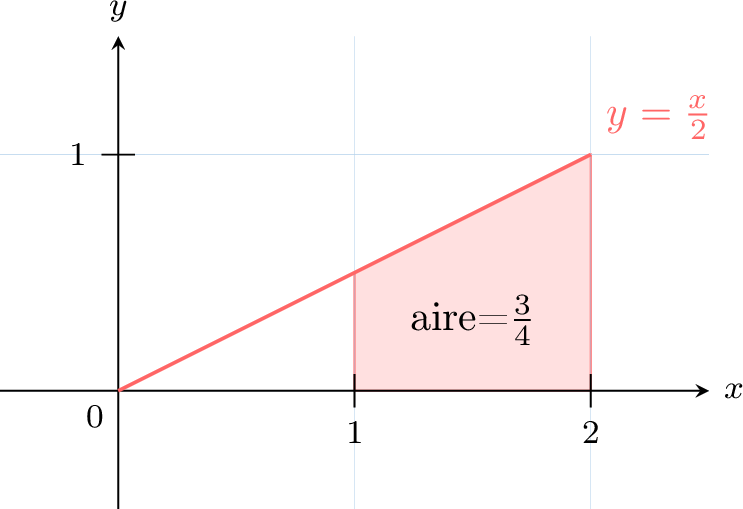

Expectation
The expectation (or expected value) of a continuous random variable is the "average" value it would take if the experiment were repeated infinitely. It represents the center of the distribution and is calculated as a discrete random variable:$$\begin{aligned}[t]E(X)&=\sum_{x\in[a,b]}x P(x \leqslant X < x+\mathrm d x)\\&=\sum_{x\in[a,b]}x \dfrac{P(x \leqslant X < x+\mathrm d x)}{\mathrm d x}\mathrm d x\\&=\int_{a}^b xf(x)\;\mathrm d x\\\end{aligned}$$
Definition Expectation
For a continuous random variable \(X\) with density \(f\) on \([a, b]\), the expected value is $$E(X) = \int_{a}^{b} x f(x) \, dx.$$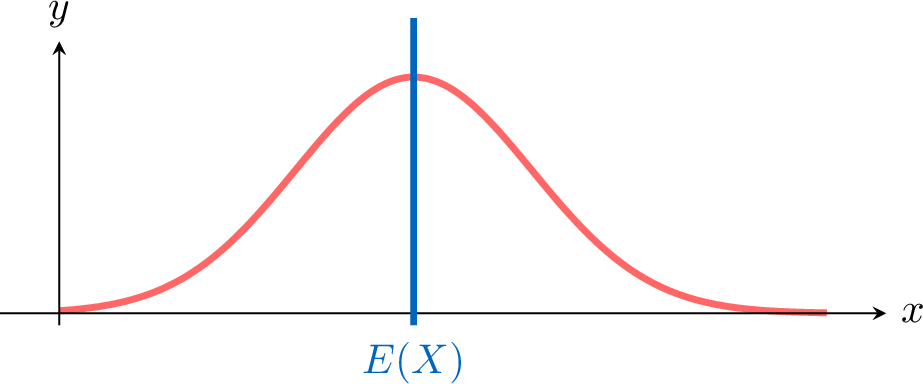

Example
The random variable \(X\) with values on \([0, 3]\) has density \(f(x) = \frac{x^2}{9}\):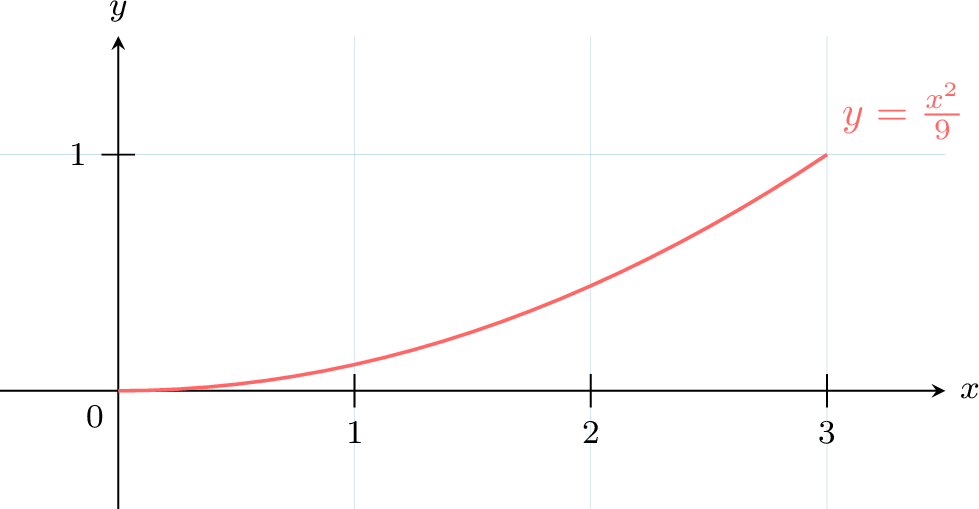

Compute \(E(X)\): $$ \begin{aligned}[t] E(X) &= \int_{0}^{3} x \cdot \frac{x^2}{9} \, dx \\ &= \int_{0}^{3} \frac{x^3}{9} \, dx \\ &= \left[ \frac{x^4}{36} \right]_{0}^{3} \\ &= \frac{3^4}{36} - 0 \\ &= 2.25 \end{aligned} $$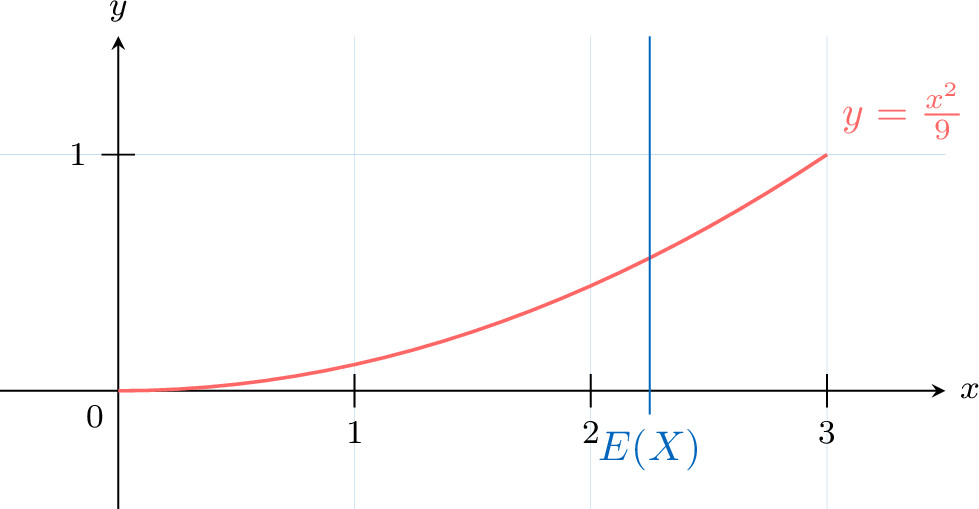

Example
The random variable \(X\) with values on \([0, 2]\) has density \(f(x) = \frac{x}{2}\):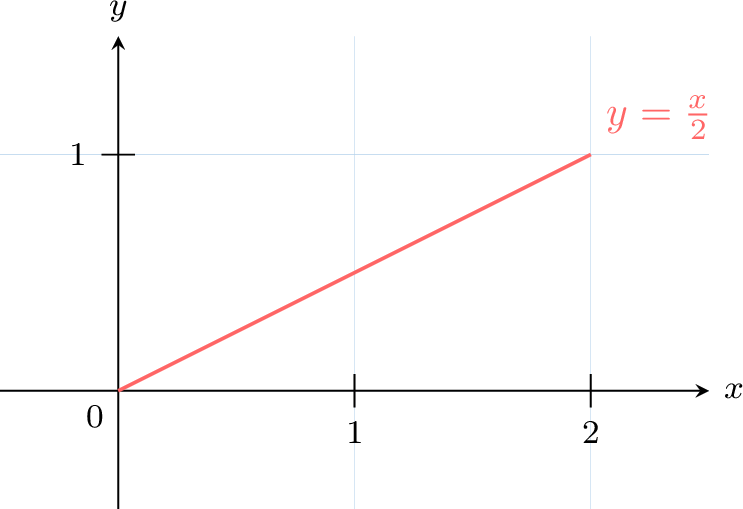

Compute \(E(X)\):$$\begin{aligned}[t]E(X) &= \int_{0}^{2} x \cdot \frac{x}{2} \, dx \\&= \int_{0}^{2} \frac{x^2}{2} \, dx \\&= \left[ \frac{x^3}{6} \right]_{0}^{2} \\&= \frac{2^3}{6} - 0 \\&= \frac{8}{6} \\&= \frac{4}{3} \\\end{aligned}$$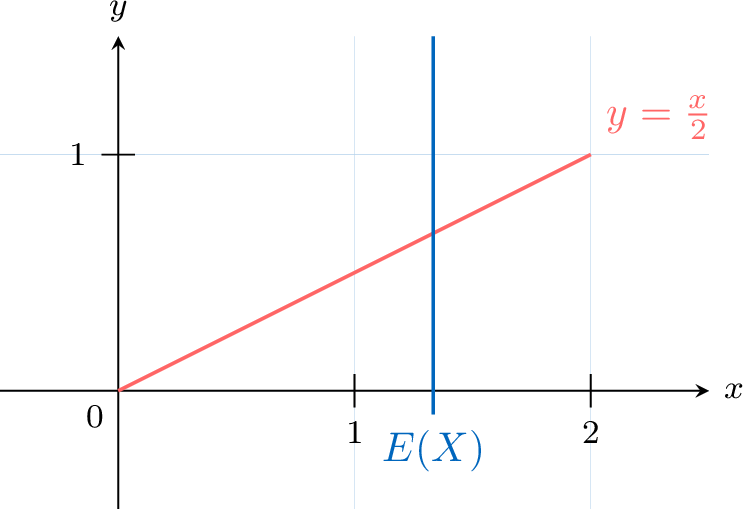

Variance
The variance of a continuous random variable measures the spread of its values around the expected value if the experiment were repeated infinitely. It quantifies the distribution’s dispersion and can be calculated as a discrete random variable:$$\begin{aligned}[t]V(X) &= \sum_{x \in [a, b]} (x - E(X))^2 P(x \leq X < x + dx) \\&= \sum_{x \in [a, b]} (x - E(X))^2 \frac{P(x \leq X < x + dx)}{dx} \cdot dx \\&= \int_{a}^{b} (x - E(X))^2 f(x) \, dx\end{aligned}$$
Definition Variance and Standard Deviation
For a continuous random variable \(X\) with density \(f\) on \([a, b]\), the variance is$$V(X) = \int_{a}^{b} (x - E(X))^2 f(x) \, dx.$$The standard deviation is$$\sigma = \sqrt{V(X)}.$$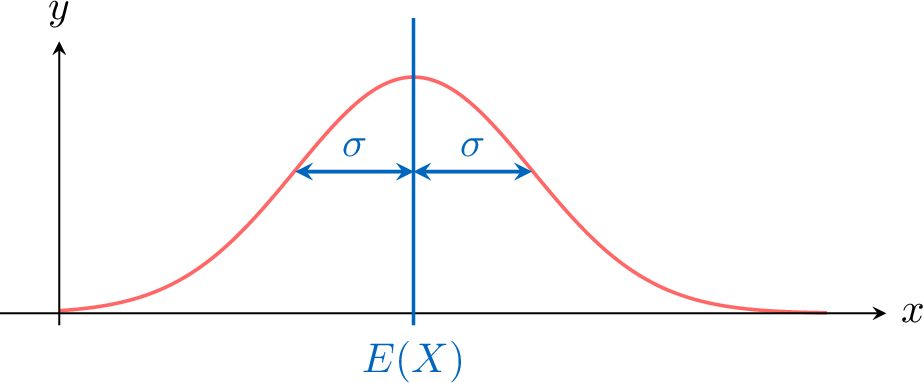

Proposition
An alternative formula for variance is:$$V(X) = \int_{a}^{b} x^2 f(x) \, dx - [E(X)]^2$$
Example
The random variable \(X\) with values on \([0, 2]\) has density \(f(x) = \frac{x}{2}\).
Find \(V(X)\).
Find \(V(X)\).
- Compute \(E(X)\): $$ \begin{aligned}[t] E(X) &= \int_{0}^{2} x \cdot \frac{x}{2} \, dx \\ &= \int_{0}^{2} \frac{x^2}{2} \, dx \\ &= \left[ \frac{x^3}{6} \right]_{0}^{2} \\ &= \frac{2^3}{6} - 0 \\ &= \frac{8}{6} \\ &= \frac{4}{3} \\ \end{aligned} $$
- Compute \(\int_{0}^{2} x^2 \cdot f(x) \, dx\): $$ \begin{aligned}[t] \int_{0}^{2} x^2 \cdot f(x) \, dx &=\int_{0}^{2} x^2 \cdot \frac{x}{2} \, dx\\ &= \int_{0}^{2} \frac{x^3}{2} \, dx \\ &= \left[ \frac{x^4}{8} \right]_{0}^{2} \\ &= \frac{2^4}{8} - 0 \\ &= \frac{16}{8} \\ &= 2 \end{aligned} $$
- Compute \(V(X)\) using the alternative formula: $$ \begin{aligned}[t] V(X) &= \int_{0}^{2} x^2 \cdot f(x) \, dx - [E(X)]^2 \\ &= 2 - \left(\frac{4}{3}\right)^2 \\ &= 2 - \frac{16}{9} \\ &= \frac{18}{9} - \frac{16}{9} \\ &= \frac{2}{9} \end{aligned} $$
Continuous Uniform Distribution
The continuous uniform distribution applies to events that are equally likely across an interval, such as the spinner example. The density is constant over the range.
Definition Continuous Uniform Distribution
A continuous random variable \(X\) follows a continuous uniform distribution on \([a, b]\) if its density is:$$f(x) = \frac{1}{b - a} \quad \text{for} \quad a \leq x \leq b$$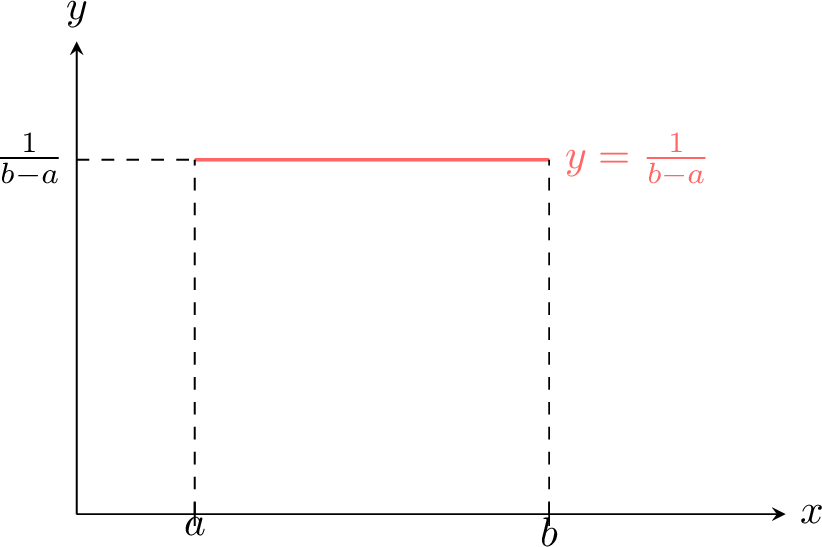

Proposition Properties
Let \( X \) be a continuous random variable following a continuous uniform distribution on \([a, b]\):
- for all \( c, d \in [a, b] : P(c \leq X \leq d) = \frac{d - c}{b - a}\),
- \(E(X) = \frac{a + b}{2}\).
- Probability: $$ \begin{aligned}[t] P(c \leq X \leq d) &= \int_{c}^{d} \frac{1}{b - a} \, dx \\ &= \left[ \frac{x}{b - a} \right]_{c}^{d} \\ &= \frac{d - c}{b - a} \end{aligned} $$
- Expected value: $$ \begin{aligned}[t] E(X) &= \int_{a}^{b} x \cdot \frac{1}{b - a} \, dx \\ &= \left[ \frac{x^2}{2(b - a)} \right]_{a}^{b} \\ &= \frac{b^2 - a^2}{2(b - a)} = \frac{(b - a)(b + a)}{2(b - a)} = \frac{a + b}{2} \end{aligned} $$
Normal Distribution
The normal distribution is a key continuous distribution in statistics, often used to model real-world phenomena (e.g., heights, test scores) due to the Central Limit Theorem. This theorem states that the sum or average of many independent random variables, under certain conditions, approximates a normal distribution as the sample size increases. The normal curve is bell-shaped, symmetric, and centered at its mean.
For example, we plot a histogram of the heights of boys at the university. The distribution represented by the histogram follows a bell-shaped curve, also known as a normal distribution.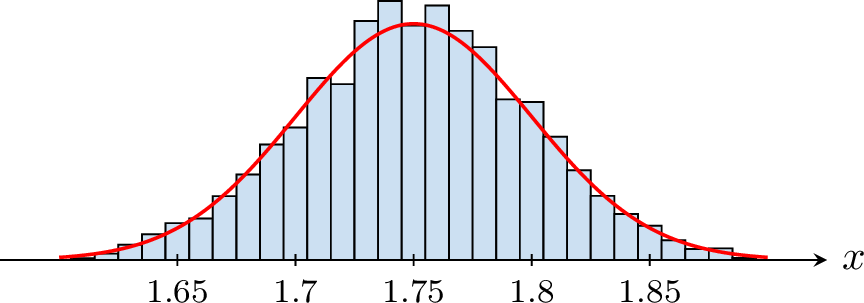
For example, we plot a histogram of the heights of boys at the university. The distribution represented by the histogram follows a bell-shaped curve, also known as a normal distribution.

Standard Normal Distribution
Definition Standard Normal Distribution
A continuous random variable \(X\) follows a standard normal distribution (or \(Z\)-distribution) if its density is:$$f(x) = \frac{1}{\sqrt{2\pi}} e^{-\frac{x^2}{2}}, \quad -\infty < x < \infty$$The probability over an interval is:$$P(a \leq X \leq b) = \int_{a}^{b} \frac{1}{\sqrt{2\pi}} e^{-\frac{x^2}{2}} \, dx$$This is denoted \(X \sim \mathcal{N}(0, 1)\).

Remark
The total probability is 1:$$\int_{-\infty}^{\infty} \frac{1}{\sqrt{2\pi}} e^{-\frac{x^2}{2}} \, dx = 1$$This is the area under the entire curve.

Normal Distribution
Definition Normal Distribution
A continuous random variable \(X\) follows a normal distribution if its density is:$$f(x) = \frac{1}{\sigma \sqrt{2\pi}} e^{-\frac{1}{2} \left( \frac{x - \mu}{\sigma} \right)^2}, \quad -\infty < x < \infty$$where \(\mu\) is the mean and \(\sigma^2\) is the variance. The graph is a normal curve (bell-shaped), denoted \(X \sim \mathcal{N}(\mu, \sigma^2)\).

Proposition Expectation and Variance
For \(X \sim \mathcal{N}(\mu, \sigma^2)\):
- \(E(X) = \mu\),
- \(V(X) = \sigma^2\).
Proposition Coverage Probabilities
For \(X \sim \mathcal{N}(\mu, \sigma^2)\):
- \(P(\mu - \sigma \leq X \leq \mu) = P(\mu \leq X \leq \mu + \sigma) \approx 34.13\pourcent\),
- \(P(\mu - 2\sigma \leq X \leq \mu - \sigma) = P(\mu + \sigma \leq X \leq \mu + 2\sigma) \approx 13.59\pourcent\),
- \(P(\mu - 3\sigma \leq X \leq \mu - 2\sigma) = P(\mu + 2\sigma \leq X \leq \mu + 3\sigma) \approx 2.15\pourcent\),
- \(P(X \leq \mu - 3\sigma) = P(\mu + 3\sigma \leq X) \approx 0.13\pourcent\).

- \(P(\mu - \sigma \leq X \leq \mu) \approx 34.13\pourcent\) means about 34.13\(\pourcent\) of values lie between \(\mu - \sigma\) and \(\mu\).
- Probabilities are additive: \(P(\mu - \sigma \leq X \leq \mu + \sigma) \approx 34.13\pourcent + 34.13\pourcent = 68.26\pourcent\).
Example
Students’ heights at a school are normally distributed with mean \(\mu = 172 \, \text{cm}\) and standard deviation \(\sigma = 8 \, \text{cm}\).
- Find the percentage of students with heights between 164 cm and 172 cm.
- Find the percentage between 164 cm and 180 cm.
- Find the percentage with heights above 196 cm.
- Find the percentage with heights below 196 cm.
- In a group of 500 students, how many are expected to have heights between 164 cm and 180 cm?

- \(P(164 \leq X \leq 172) = P(\mu - \sigma \leq X \leq \mu) = 34.13\pourcent\).
- \(P(164 \leq X \leq 180) = P(\mu - \sigma \leq X \leq \mu + \sigma) = 34.13\pourcent + 34.13\pourcent = 68.26\pourcent\).
- \(P(X > 196) = P(X \geq \mu + 3\sigma) = 0.13\pourcent\).
- \(P(X < 196) = 1 - P(X \geq 196) = 100\pourcent - 0.13\pourcent = 99.87\pourcent\).
- Expected number = \(68.26\pourcent \times 500 = 0.6826 \times 500 \approx 341\) students.
Quantile
Definition Quantile
The value \(x\) such that \(P(X \leq x) = 0.95\) is the 95\(\pourcent\)-quantile, meaning 95\(\pourcent\) of the distribution lies below \(x\).
Example
\(X \sim \mathcal{N}(7, 2^2)\). Find the 95\(\pourcent\)-quantile.
Using a calculator (e.g., inverse normal function), for \(P(X \leq x) = 0.95\) with \(\mu = 7\) and \(\sigma = 2\), we find \(x \approx 10.29\).
